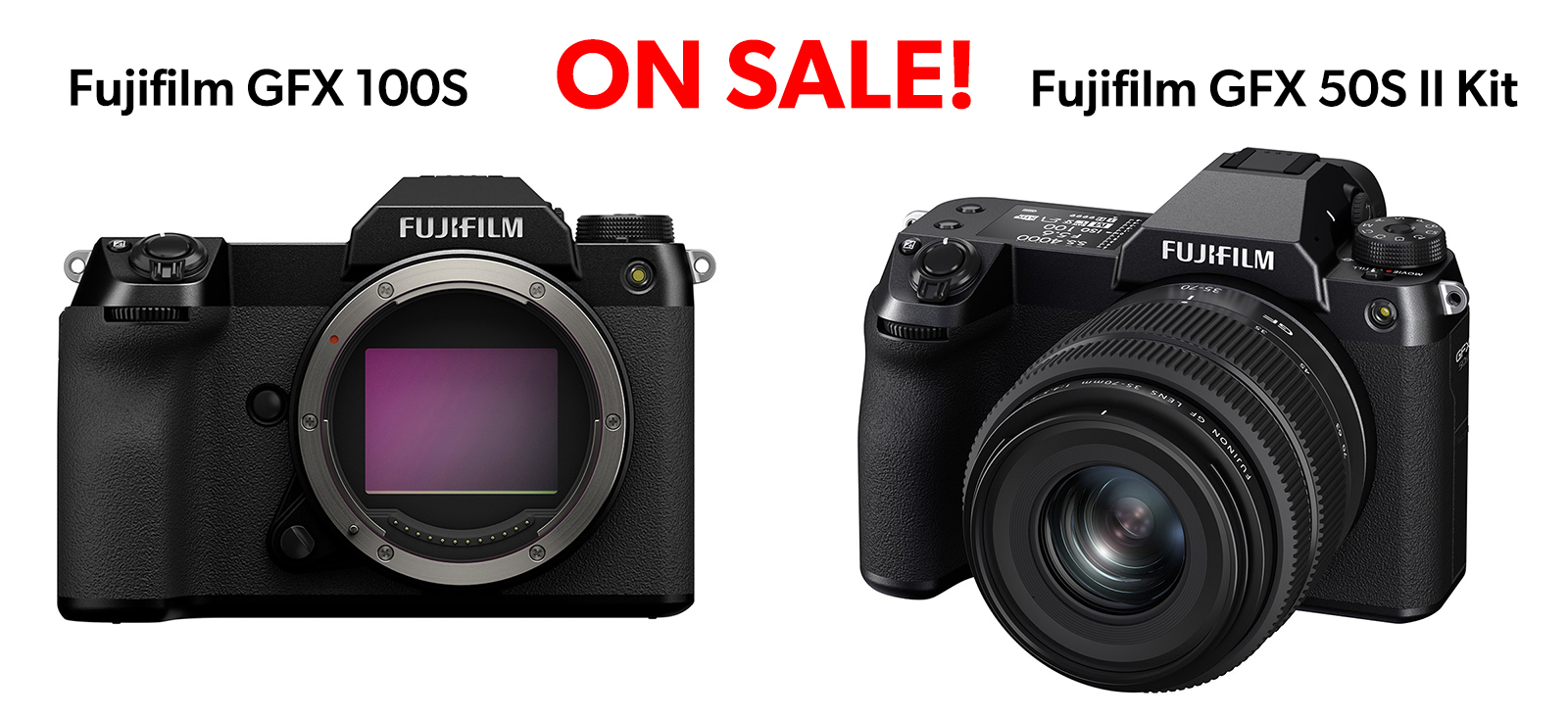We have our final two open-box (but in pristine shape – never rented or even shot with, just looked at) GFX models at some great prices, since they are being discontinued. Please call us if you’d like details, but both are significantly discounted and ideal for those who don’t necessarily need the very latest and greatest, especially since they are both still absolutely superb cameras!
The GFX 100S body used to be $7,800 but the newer GFX 100S II is coming in at only $6,750 so… that means some aggressive sale pricing on the old model! Current regular sale pricing is $5,950, a whopping $1,850 discount but… since our last unit is an open-box, we are dropping that down to $5,260 for a GFX 100S, which is a savings of $2,540!
Here is a review with many samples: Tested! Fujifilm GFX 100S Body
The GFX 50S II Kit w/GF 35-70mm f/4.5-5.6 WR zoom was $5,625, on sale for $4,675 but as an open box, it’s now $4,125 for the GFX 50S II w/GF 35-70mm, which is a savings of $1,500!
A brief review with some samples here: Tested! Fujifilm GFX 50S II Kit w/GF 35-70mm
Keep in mind that the sale pricing only lasts until September 8th, and we only have one of each at those prices.
So, the question is: should you go with the latest and greatest, at least for the 100 megapixel model, or should you save nearly $1,500 and buy the previous generation? Then, as far as at the GFX 50S II… well that sensor is going away entirely, so if you want a 50MP model since you may not need 100MP, or maybe you want the reliability of contrast-detect AF for static subjects (landscapes, cityscapes, architecture, product, static portraits)… wait, what? Reliable? Yes actually… okay, let me explain that before I get into the differences in the GFX 100S series…
The 50MP medium format sensor has been used in all of the GFX 50 series models (GFX 50S, GFX 50R, GFX 50S II) and it does not include any “phase-detect” pixels, so autofocus with those cameras is performed purely with a rapid contrast-detect “shuffle”, quickly moving the lens back and forth to determine at which point the area under the focus point has the highest contrast, and this is how the camera determines when that point is at its sharpest. Phase detect autofocus works by comparing the light coming in from two different directions, using right and left partially masked pixels, and then using the phase difference to calculate where to position the lens’ focus in one rapid movement.
Phase detect AF is far faster than contrast detect (nearly instant, versus maybe a 1/3 to half a second -or so- for a contrast-detect shuffle), but phase-detect can be prone to errors in some situations (repeating patterns for example) and can be fooled, resulting in mis-focused shots. I have seen phase detect AF errors crop up on all modern digital cameras I have shot with over the years, including Nikon, Canon and Fujifilm. On the other hand, my original Fujifilm X-E1 (also contrast-detect only, like the GFX 50S II) was the most reliable camera I had ever used for static subject focus accuracy. In scenarios where you need the most accurate AF, and speed is not an issue, then I would actually prefer contrast-detect AF and personally, I wish one could turn off phase-detect AF on any mirrorless camera when speed is not an issue.
Some manufacturers use a hybrid system for single-shot AF, doing the bulk of the lens AF movement with a rapid phase-detect calculated shift, then performing a rapid, tight, contrast-detect shuffle (much faster than a full contrast-detect shuffle) to confirm or fine tune the focus. This gives the best of both worlds: single shot AF that is essentially as fast as a pure phase-detect system with the pinpoint accuracy of a pure contrast-detect system. Personally, I wish Fujifilm would adopt this strategy for single shot AF as well, presuming it is not patented (or license the patent)…
As much as I like contrast-detect for static subjects, on the other hand if your subject is moving (sports, wildlife, dynamically posing models, runway fashion, dancers, cars, motorcycles etc.), for those subjects your keeper rate with contrast-detect AF would be depressingly low. For those types of shots, phase-detect AF is an absolute must since even if you only get 6 or 7 out of 10 keepers, that is far better than maybe 1 out of 10 if relying on a contrast-detect system.
Of course there are tricks that photographers have learned over the years, those that worked with manual focus cameras. Simply anticipate and pre-focus where you want to capture your subject, and when it arrives at the spot, shoot! Sure, you might only get one shot that way, but if you time it right, it’ll be a keeper, and that’s how film photographers worked for decades. You can also zone-focus, set a distance, then choose an f-stop which gives some workable depth of-field around the plane of focus, which is often how one would do street photography back in the day. That said, if you are planning to shoot with a 50mm f/1.2 lens wide open (or a Fujinon GF 80mm wide open at f/1.7), well that trick won’t yield many keepers at all! However, take a 35mm prime set to f/8 (or a Fujinon GF 45mm lens set to f/11), as an example, and that could well work for you. Digital cameras are so good these days at higher ISOs that would still be able to get sufficiently fast shutter speeds even if shooting at f/11. Of course the reason I mentioned all that, is that those manual focus tricks to capture moving subjects will work just great for a slow-to-focus contrast-detect Fujifilm body as well. So… if you don’t need 100 megapixels and primarily photograph static subjects, the GFX 50S II kit might be quite an affordable way of getting that medium format look. Now that my contrast-detect/phase-detect rant is over, on to the GFX 100S…
As far as the GFX 100S versus the GFX 100S II… well the new version II does have a better EVF (slightly higher resolution, refresh rate and magnification), a faster processor with more effective subject-recognition AF tracking and face/eye detection, and the II can now capture stills at 7fps and not just 5fps. The 100S II also has far more video options and tools, and far better AF during video capture, less rolling shutter, as well as an IBIS system rated for 8 stops instead of 6 stops, although heck, I could already handhold 1/2 second exposures on the GFX 100S – see my review and image samples linked above. So… despite a number of improvements, if you are shooting mainly static subjects and not doing much video, the new camera might not be worth the extra money. Image quality, while said to be ever so slightly better on the new version, is going to be basically the same for the vast majority of real world shots. Sure the new EVF is better, but the GFX 100S EVF is pretty darn good too! We do have a rental GFX 100S you can check out, should you wonder about its EVF…
So there you have it, a quick recap of the previous models to try and help you decide which direction to go. Spend more on the latest and greatest, or save some money and buy a very competent last-generation model? Personally, I am a bit sad the 50MP series is going away actually, since I too had been potentially interested in a GFX setup (I was seriously eyeing the GFX 50R and actually liked the fact that it was only contrast-detect), but I suppose that with 35mm full-frame digital cameras already hitting 60 megapixels, and many models from both Canon and Nikon being at 45MP, it probably makes more sense for Fujifilm to standardize on the 100MP sensor for their medium format cameras.
So… if you are interested in a great deal on either of those two open box GFX cameras, don’t delay! There won’t be any more stock coming!




